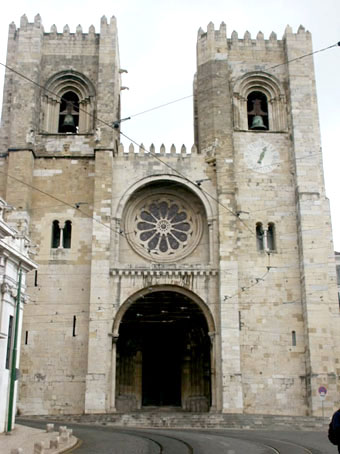
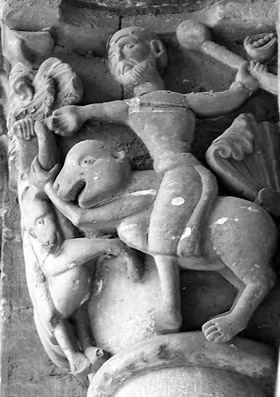
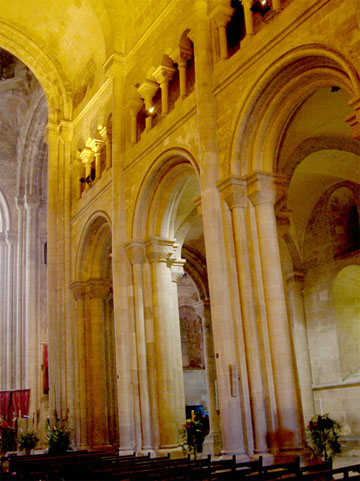
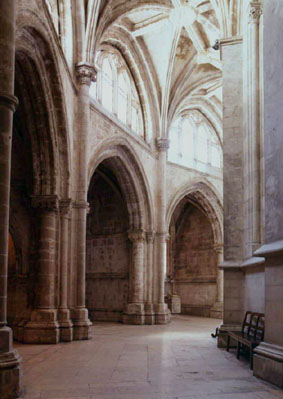
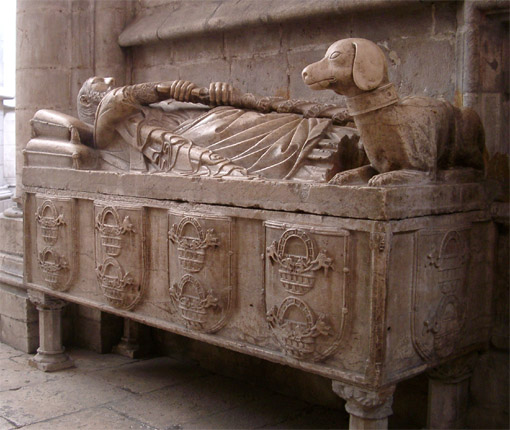
Index
| S� de Lisboa - Page 1 | |||||||||||||||||||||||||||||
| The history of Lisbon Cathedral (S� de Lisboa) begins in 1147, when the city was conquered from the Moors by a Christian army. This army was composed of Portuguese troops led by King Afonso Henriques and Anglo-Norman, Flemish and German troops taking part on the Second Crusade. The crusaders were going to the Holy Land but decided to help the Portuguese King in exchange for a part of the booty. Many of them stayed in Portugal, never reaching the Orient. The first bishop of Lisbon after the reconquest, for instance, was an English crusader named Gilbert. | |||||||||||||||||||||||||||||
| Construction on the cathedral started soon after the taking of the city, on the site of the Lisbon mosque, and must have lasted until the middle of the 13th century. The original Romanesque building was modified many times, specially in the 14th and 18th centuries. The great tragedy to affect the cathedral was the 1755 earthquake, which partially destroyed the building. In the 20th century its mediaeval appearance was restored as much as possible by an extensive renovation. | |||||||||||||||||||||||||||||
 |
|||||||||||||||||||||||||||||
| Left � The main fa�ade of Lisbon Cathedral has a narthex (entrance gallery) with a Romanesque portal and two flanking towers. The Romanesque rose-window on the second floor was reconstructed in the 20th century based on remains found inside the church. Crenelations over the walls lend the fa�ade a fortress-like appearance. | |||||||||||||||||||||||||||||
 |
|||||||||||||||||||||||||||||
| Right - The Romanesque main portal of Lisbon Cathedral, which dates from the end of the 12th or the begining of the 13th century, has decorated capitals with various figures of difficult interpretation. The capital in the photo shows two bearded men (only one is visible) riding beasts (lionesses?) and fighting each other. The theme of fighting figures is common in Portuguese Romanesque and might be a representation of the evil of the world. Other themes of the portal include a Queen (a Virtue?), the Archangel Michael and vegetal motifs. In the interior of the cathedral most Romanesque capitals were destroyed in Baroque times. | |||||||||||||||||||||||||||||
 |
|||||||||||||||||||||||||||||
| Left - Partial view of the central and lateral aisles of Lisbon Cathedral. Originally, the cathedral had an inner organisation similar to that of the Old Cathedral of Coimbra: Roman-cross plan, three aisles, a triphorium over the central aisle, transept with a lantern tower and three Eastern chapels. The central aisle is roofed with barrel vaulting. Nowadays only the nave and the transept are still Romanesque. In the 14th century, King Afonso IV ordered the suppression of the lateral chapels and the construction of a gallery (deambulatory) encircling the main chapel. The main chapel was rebuilt in Gothic style to serve as funerary chapel for the King and his family. Unfortunately, this Gothic main chapel was destroyed in the 1755 earthquake and was rebuilt in Neoclassical style. | |||||||||||||||||||||||||||||
 |
|||||||||||||||||||||||||||||
| Right - The elegant Gothic deambulatory was erected during the reign of D. Afonso IV (1325-1357). It consists of a gallery with a series of chapels, an upper tier of windows and a ribbed vaulted ceiling. The chapels have each three windows and are also roofed by ribbed vaulting. There are some interesting Gothic tombs in this part of the cathedral. | |||||||||||||||||||||||||||||
 |
|||||||||||||||||||||||||||||
| Up - One of the tombs of the deambulatory is that of Lopo Fernandes Pacheco, who was an aide of King Afonso IV. His coat-of-arms is seen on the side of the tomb. A dog, symbol of fidelity, guards the statue of the warrior, who is holding his sword as prepared for battle. This and the other tombs of the cathedral are masterpieces of 14th century-Portuguese Gothic sculpture. His wife, D. Maria Vila Lobos, is buried in a similar tomb in the same chapel. | |||||||||||||||||||||||||||||
| Page 2 Index |
|||||||||||||||||||||||||||||